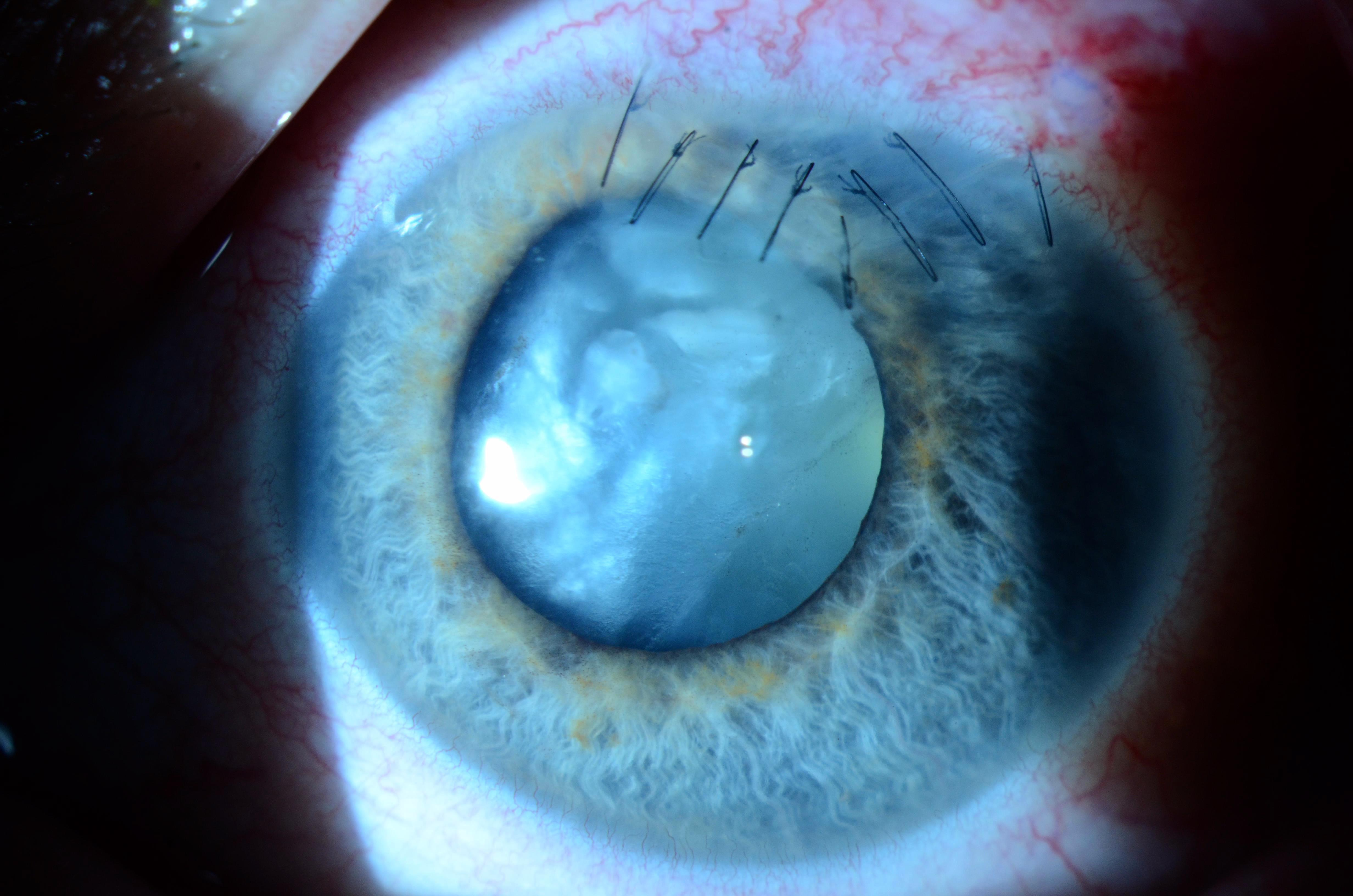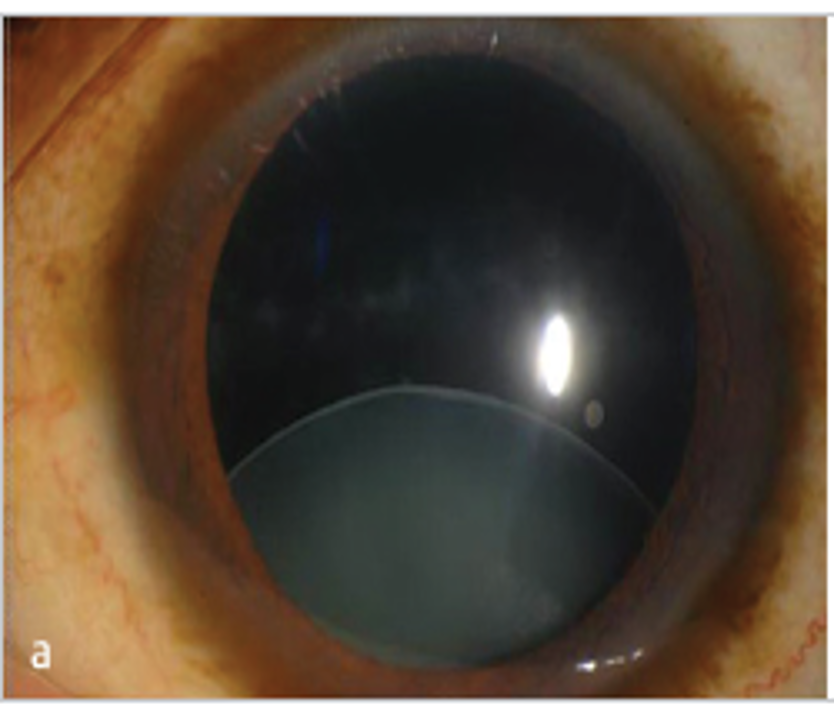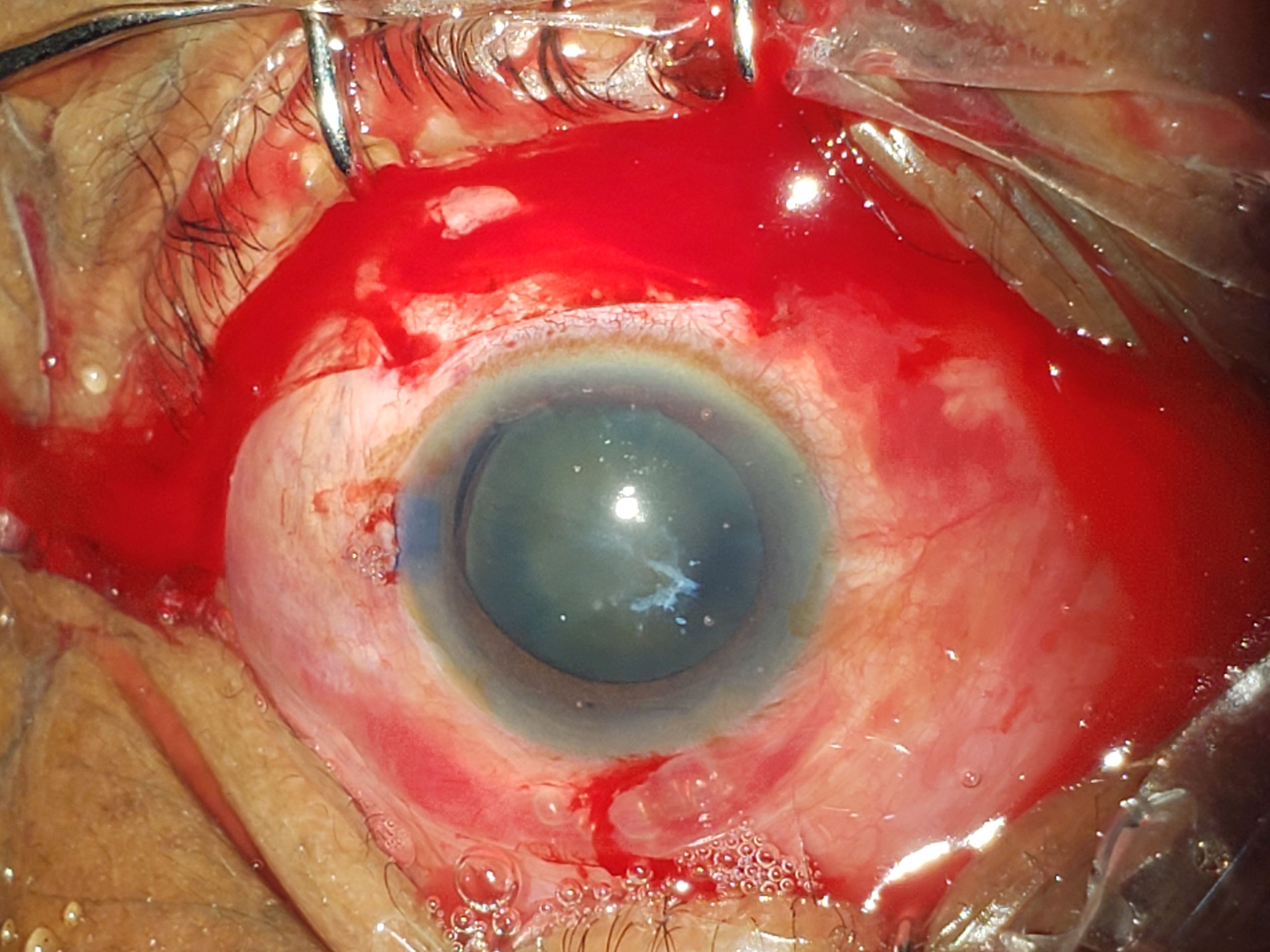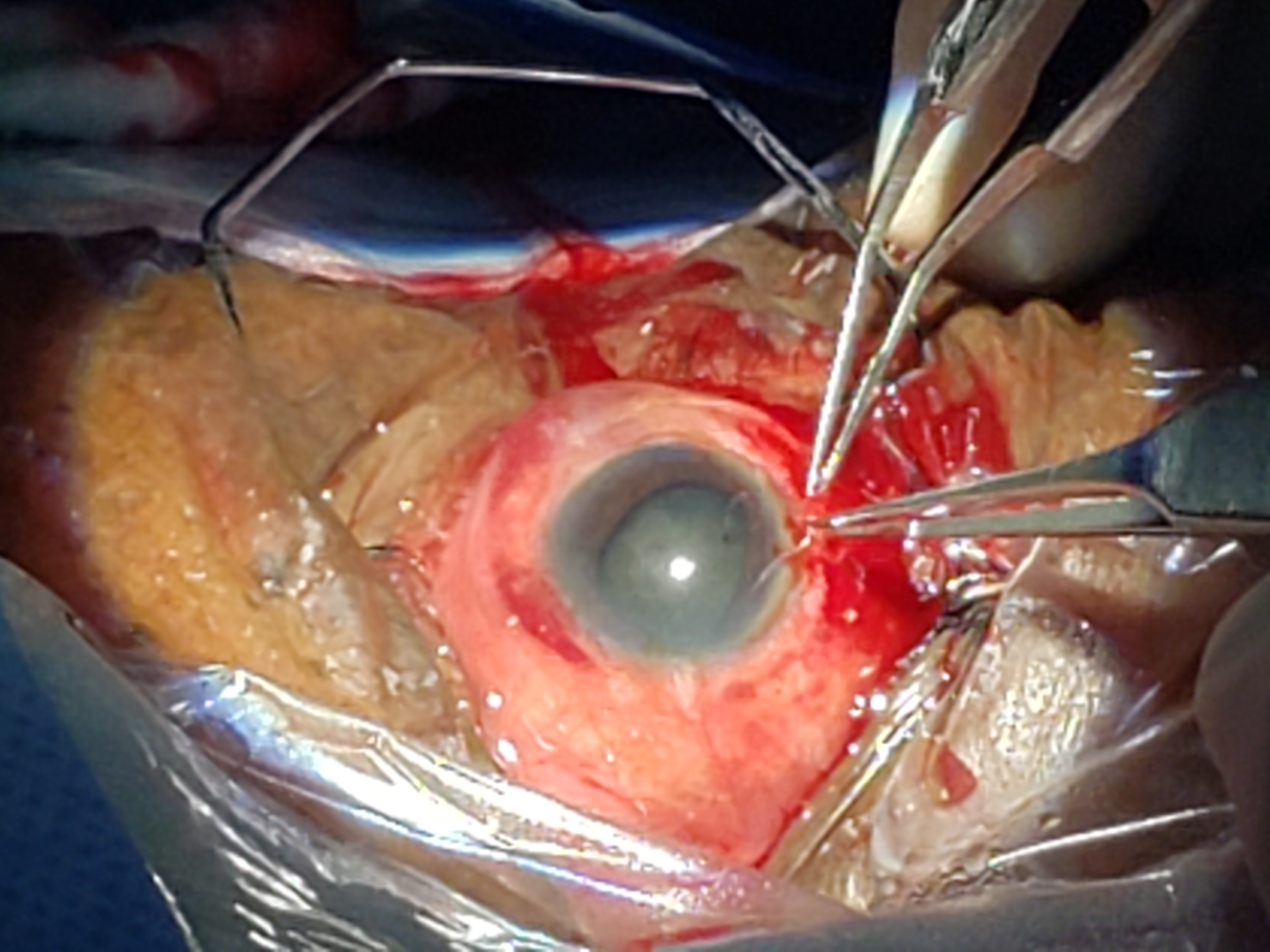[1]
Khokhar S, Gupta S, Yogi R, Gogia V, Agarwal T. Epidemiology and intermediate-term outcomes of open- and closed-globe injuries in traumatic childhood cataract. European journal of ophthalmology. 2014 Jan-Feb:24(1):124-30. doi: 10.5301/ejo.5000342. Epub 2013 Jul 26
[PubMed PMID: 23918072]
[2]
Peleja MB, da Cunha FBS, Peleja MB, Rohr JTD. Epidemiology and prognosis factors in open globe injuries in the Federal District of Brazil. BMC ophthalmology. 2022 Mar 9:22(1):111. doi: 10.1186/s12886-021-02183-z. Epub 2022 Mar 9
[PubMed PMID: 35264122]
[3]
Baur ID, Auffarth GU, Łabuz G, Khoramnia R. [Implantation of a Toric IOL with Enhanced Depth of Focus for Unilateral Traumatic Cataract]. Klinische Monatsblatter fur Augenheilkunde. 2023 Jun:240(6):819-823. doi: 10.1055/a-1809-5187. Epub 2022 May 17
[PubMed PMID: 35580622]
[4]
Chaudhary A, Singh R, Singh SP. Prognostic value of Ocular Trauma Score and pediatric Penetrating Ocular Trauma Score in predicting the visual prognosis following ocular injury. Romanian journal of ophthalmology. 2022 Apr-Jun:66(2):146-152. doi: 10.22336/rjo.2022.29. Epub
[PubMed PMID: 35935081]
[5]
Zhu AY, Kraus CL. Practice Patterns in the Surgical Management of Pediatric Traumatic Cataracts. Journal of pediatric ophthalmology and strabismus. 2020 May 1:57(3):190-198. doi: 10.3928/01913913-20200304-01. Epub
[PubMed PMID: 32453853]
[6]
Gupta VB, Rajagopala M, Ravishankar B. Etiopathogenesis of cataract: an appraisal. Indian journal of ophthalmology. 2014 Feb:62(2):103-10. doi: 10.4103/0301-4738.121141. Epub
[PubMed PMID: 24618482]
[7]
Shanbagh S, Matalia J, Kannan R, Shetty R, Panmand P, Muthu SO, Chaurasia SS, Deshpande V, Bhattacharya SS, Gopalakrishnan AV, Ghosh A. Distinct gene expression profiles underlie morphological and etiological differences in pediatric cataracts. Indian journal of ophthalmology. 2023 May:71(5):2143-2151. doi: 10.4103/IJO.IJO_3269_22. Epub
[PubMed PMID: 37203095]
[8]
Sen P, Sreelakshmi K, Bhende P, Gopal L, Rishi P, Rishi E, Susvar P, Attiku Y. Outcome of Sutured Scleral-Fixated Intraocular Lens in Blunt and Penetrating Trauma in Children. Ophthalmic surgery, lasers & imaging retina. 2018 Oct 1:49(10):757-764. doi: 10.3928/23258160-20181002-03. Epub
[PubMed PMID: 30395661]
[9]
Stepp MA, Menko AS. Immune responses to injury and their links to eye disease. Translational research : the journal of laboratory and clinical medicine. 2021 Oct:236():52-71. doi: 10.1016/j.trsl.2021.05.005. Epub 2021 May 27
[PubMed PMID: 34051364]
[10]
Hilely A, Leiba H, Achiron A, Hecht I, Parness-Yossifon R. Traumatic Cataracts in Children, Long-Term Follow-up in an Israeli Population: A Retrospective Study. The Israel Medical Association journal : IMAJ. 2019 Sep:21(9):599-602
[PubMed PMID: 31542904]
Level 2 (mid-level) evidence
[11]
Tartarella MB, Britez-Colombi GF, Milhomem S, Lopes MC, Fortes Filho JB. Pediatric cataracts: clinical aspects, frequency of strabismus and chronological, etiological, and morphological features. Arquivos brasileiros de oftalmologia. 2014 May-Jun:77(3):143-7
[PubMed PMID: 25295898]
[12]
Agrawal R, Ho SW, Teoh S. Pre-operative variables affecting final vision outcome with a critical review of ocular trauma classification for posterior open globe (zone III) injury. Indian journal of ophthalmology. 2013 Oct:61(10):541-5. doi: 10.4103/0301-4738.121066. Epub
[PubMed PMID: 24212303]
[13]
Shah M, Shah S, Upadhyay P, Agrawal R. Controversies in traumatic cataract classification and management: a review. Canadian journal of ophthalmology. Journal canadien d'ophtalmologie. 2013 Aug:48(4):251-8. doi: 10.1016/j.jcjo.2013.03.010. Epub
[PubMed PMID: 23931462]
[14]
Asano N, Schlötzer-Schrehardt U, Dörfler S, Naumann GO. Ultrastructure of contusion cataract. Archives of ophthalmology (Chicago, Ill. : 1960). 1995 Feb:113(2):210-5
[PubMed PMID: 7864754]
[15]
El Kaissoumi L, Mrini B. [Neglected post-traumatic ruptured cataract]. The Pan African medical journal. 2022:42():3. doi: 10.11604/pamj.2022.42.3.33130. Epub 2022 May 4
[PubMed PMID: 35685383]
[16]
Fagerholm PP, Philipson BT. Human traumatic cataract. A quantitative microradiographic and electron microscopic study. Acta ophthalmologica. 1979 Feb:57(1):20-32
[PubMed PMID: 419973]
[17]
Bendeddouche K, Assaf E, Emadisson H, Forestier F, Salvanet-Bouccara A. [Air bags and eye injuries: chemical burns and major traumatic ocular lesions--a case study]. Journal francais d'ophtalmologie. 2003 Oct:26(8):819-23
[PubMed PMID: 14586223]
Level 3 (low-level) evidence
[18]
Rodricks D, Loya A, Mohamed M, Al-Mohtaseb Z. Visual outcomes of open globe injury patients with traumatic cataracts. International ophthalmology. 2022 Jul:42(7):2039-2046. doi: 10.1007/s10792-021-02195-0. Epub 2022 Feb 8
[PubMed PMID: 35133577]
[19]
Khatri A, Shrestha SM, Kuhn F, Subramanian P, Hoskin AK, Pradhan E, Agrawal R. Ophthalmic Trauma Correlation Matrix (OTCM): a potential novel tool for evaluation of concomitant ocular tissue damage in open globe injuries. Graefe's archive for clinical and experimental ophthalmology = Albrecht von Graefes Archiv fur klinische und experimentelle Ophthalmologie. 2022 May:260(5):1773-1778. doi: 10.1007/s00417-021-05491-8. Epub 2021 Nov 18
[PubMed PMID: 34792638]
[20]
Doğan E, Çelik E, Gündoğdu KÖ, Alagöz G. Characteristics of pediatric traumatic cataract and factors affecting visual outcomes. Injury. 2023 Jan:54(1):168-172. doi: 10.1016/j.injury.2022.09.034. Epub 2022 Sep 21
[PubMed PMID: 36167690]
[21]
Goldblum D, Körner F, Garweg JG. [Pharmacological therapy approaches in ocular traumatology]. Therapeutische Umschau. Revue therapeutique. 2001 Jan:58(1):8-12
[PubMed PMID: 11217490]
[22]
Memon MN, Narsani AK, Nizamani NB. Visual outcome of unilateral traumatic cataract. Journal of the College of Physicians and Surgeons--Pakistan : JCPSP. 2012 Aug:22(8):497-500
[PubMed PMID: 22868014]
[23]
Mangan MS, Arıcı C, Tuncer İ, Yetik H. Isolated Anterior Lens Capsule Rupture Secondary to Blunt Trauma: Pathophysiology and Treatment. Turkish journal of ophthalmology. 2016 Aug:46(4):197-199. doi: 10.4274/tjo.85547. Epub 2016 Aug 15
[PubMed PMID: 28058159]
[24]
Elksnis Ē, Vanags J, Elksne E, Gertners O, Laganovska G. Isolated posterior capsule rupture after blunt eye injury. Clinical case reports. 2021 Apr:9(4):2105-2108. doi: 10.1002/ccr3.3956. Epub 2021 Feb 18
[PubMed PMID: 33936647]
Level 3 (low-level) evidence
[25]
Gulati S, Hanebrink KA, Henry M, Munro M, Chan RVP, Edward DP. Open globe injury and intraocular foreign body following crossbow-related penetrating ocular trauma. American journal of ophthalmology case reports. 2022 Jun:26():101441. doi: 10.1016/j.ajoc.2022.101441. Epub 2022 Feb 23
[PubMed PMID: 35252625]
Level 3 (low-level) evidence
[26]
Smith MP, Colyer MH, Weichel ED, Stutzman RD. Traumatic cataracts secondary to combat ocular trauma. Journal of cataract and refractive surgery. 2015 Aug:41(8):1693-8. doi: 10.1016/j.jcrs.2014.12.059. Epub
[PubMed PMID: 26432127]
[27]
Liu X, Wang L, Du C, Li D, Fan Y. Mechanism of lens capsular rupture following blunt trauma: a finite element study. Computer methods in biomechanics and biomedical engineering. 2015:18(8):914-21. doi: 10.1080/10255842.2014.975798. Epub
[PubMed PMID: 25427212]
[28]
Inanc M, Tekin K, Erol YO, Sargon MF, Koc M, Budakoglu O, Yılmazbas P. The ultrastructural alterations in the lens capsule and epithelium in eyes with traumatic white cataract. International ophthalmology. 2019 Jan:39(1):47-53. doi: 10.1007/s10792-017-0783-0. Epub 2017 Nov 30
[PubMed PMID: 29189944]
[29]
Singh RB, Thakur S, Ichhpujani P. Traumatic rosette cataract. BMJ case reports. 2018 Nov 28:11(1):. doi: 10.1136/bcr-2018-227465. Epub 2018 Nov 28
[PubMed PMID: 30567140]
Level 3 (low-level) evidence
[30]
Marcantonio JM, Syam PP, Liu CS, Duncan G. Epithelial transdifferentiation and cataract in the human lens. Experimental eye research. 2003 Sep:77(3):339-46
[PubMed PMID: 12907166]
[31]
Kuriyan AE, Flynn HW Jr, Yoo SH. Subluxed traumatic cataract: optical coherence tomography findings and clinical management. Clinical ophthalmology (Auckland, N.Z.). 2012:6():1997-9. doi: 10.2147/OPTH.S37393. Epub 2012 Dec 4
[PubMed PMID: 23271877]
[32]
Leung VC, Fung SSM, Muni R, Ali A. Phacomorphic Angle-closure Following Silicone Oil Tamponade in a Pediatric Patient. Journal of glaucoma. 2018 Jun:27(6):e106-e109. doi: 10.1097/IJG.0000000000000957. Epub
[PubMed PMID: 29613981]
[33]
Fagerholm PP. The response of the lens to trauma. Transactions of the ophthalmological societies of the United Kingdom. 1982:102 Pt 3():369-74
[PubMed PMID: 6964283]
[34]
Shah MA, Shah SM, Applewar A, Patel C, Shah S, Patel U. OcularTrauma Score: a useful predictor of visual outcome at six weeks in patients with traumatic cataract. Ophthalmology. 2012 Jul:119(7):1336-41. doi: 10.1016/j.ophtha.2012.01.020. Epub 2012 Mar 27
[PubMed PMID: 22459803]
[35]
Walker NJ, Foster A, Apel AJ. Traumatic expulsive iridodialysis after small-incision sutureless cataract surgery. Journal of cataract and refractive surgery. 2004 Oct:30(10):2223-4
[PubMed PMID: 15474840]
[36]
Rafferty NS, Goossens W. Ultrastructure of traumatic cataractogenesis in the frog: a comparison with mouse and human lens. The American journal of anatomy. 1977 Mar:148(3):385-407
[PubMed PMID: 300987]
[37]
Klysik A, Kaszuba-Bartkowiak K, Jurowski P. Axial Length of the Eyeball Is Important in Secondary Dislocation of the Intraocular Lens, Capsular Bag, and Capsular Tension Ring Complex. Journal of ophthalmology. 2016:2016():6431438. doi: 10.1155/2016/6431438. Epub 2016 Mar 16
[PubMed PMID: 27069675]
[38]
Jones WL. Traumatic injury to the lens. Optometry clinics : the official publication of the Prentice Society. 1991:1(2):125-42
[PubMed PMID: 1799823]
[39]
Shah MA, Shah SM, Shah SB, Patel UA. Effect of interval between time of injury and timing of intervention on final visual outcome in cases of traumatic cataract. European journal of ophthalmology. 2011 Nov-Dec:21(6):760-5. doi: 10.5301/EJO.2011.6482. Epub
[PubMed PMID: 21445838]
Level 3 (low-level) evidence
[40]
Batchelor A, Lacy M, Hunt M, Lu R, Lee AY, Lee CS, Saraf SS, Chee YE, IRIS Registry Analytic Center Consortium. Predictors of Long-term Ophthalmic Complications after Closed Globe Injuries Using the Intelligent Research in Sight (IRIS®) Registry. Ophthalmology science. 2023 Mar:3(1):100237. doi: 10.1016/j.xops.2022.100237. Epub 2022 Oct 28
[PubMed PMID: 36561352]
[41]
Sharma AK, Aslami AN, Srivastava JP, Iqbal J. Visual Outcome of Traumatic Cataract at a Tertiary Eye Care Centre in North India: A Prospective Study. Journal of clinical and diagnostic research : JCDR. 2016 Jan:10(1):NC05-8. doi: 10.7860/JCDR/2016/17216.7049. Epub 2016 Jan 1
[PubMed PMID: 26894101]
[42]
Singh RK, Singh S. Management of partially absorbed white soft cataract post penetrating injury to eye. Indian journal of ophthalmology. 2023 Jan:71(1):321. doi: 10.4103/ijo.IJO_1586_22. Epub
[PubMed PMID: 36588276]
[43]
Wu B, Yuan X, Chen S. Comperative analysis of accuracy between low-frequency ultrasound biomicroscopy and 14-MHz ultrasonography with tissue harmonic imaging for the evaluation of the posterior lens capsule in traumatic cataracts. BMC ophthalmology. 2021 Oct 22:21(1):375. doi: 10.1186/s12886-021-02094-z. Epub 2021 Oct 22
[PubMed PMID: 34686169]
[44]
Dezhagah H. Circular anterior lens capsule rupture caused by blunt ocular trauma. Middle East African journal of ophthalmology. 2010 Jan:17(1):103-5. doi: 10.4103/0974-9233.61227. Epub
[PubMed PMID: 20543947]
[45]
Eze KC, Enock ME, Eluehike SU. Ultrasonic evaluation of orbito-ocular trauma in Benin-City, Nigeria. The Nigerian postgraduate medical journal. 2009 Sep:16(3):198-202
[PubMed PMID: 19767906]
[46]
Agrawal R, Shah M, Mireskandari K, Yong GK. Controversies in ocular trauma classification and management: review. International ophthalmology. 2013 Aug:33(4):435-45. doi: 10.1007/s10792-012-9698-y. Epub 2013 Jan 22
[PubMed PMID: 23338232]
[47]
Xiong S, Xia X. Risk factors and surgical outcomes for the concurrence of intraocular lens dislocation with vitreoretinal diseases. Zhong nan da xue xue bao. Yi xue ban = Journal of Central South University. Medical sciences. 2022 Jul 28:47(7):881-887. doi: 10.11817/j.issn.1672-7347.2022.220264. Epub
[PubMed PMID: 36039584]
[48]
Segev Y, Goldstein M, Lazar M, Reider-Groswasser I. CT appearance of a traumatic cataract. AJNR. American journal of neuroradiology. 1995 May:16(5):1174-5
[PubMed PMID: 7639149]
[49]
Chaniyara MH, Pujari A, Aron N, Sharma N. Optimising the surgical outcome in a case of post-traumatic cataract using ultrasound biomicroscopy. BMJ case reports. 2017 Jul 26:2017():. pii: bcr-2017-220579. doi: 10.1136/bcr-2017-220579. Epub 2017 Jul 26
[PubMed PMID: 28751510]
Level 3 (low-level) evidence
[50]
Wang K, Liu J, Chen M. Role of B-scan ultrasonography in the localization of intraocular foreign bodies in the anterior segment: a report of three cases. BMC ophthalmology. 2015 Aug 14:15():102. doi: 10.1186/s12886-015-0076-1. Epub 2015 Aug 14
[PubMed PMID: 26268356]
Level 3 (low-level) evidence
[51]
Tabatabaei SA, Soleimani M, Etesali H, Naderan M. Accuracy of Swept-Source Optical Coherence Tomography and Ultrasound Biomicroscopy for Evaluation of Posterior Lens Capsule in Traumatic Cataract. American journal of ophthalmology. 2020 Aug:216():55-58. doi: 10.1016/j.ajo.2020.03.030. Epub 2020 Apr 2
[PubMed PMID: 32247777]
[52]
Mansour AM, Jaroudi MO, Hamam RN, Maalouf FC. Isolated posterior capsular rupture following blunt head trauma. Clinical ophthalmology (Auckland, N.Z.). 2014:8():2403-7. doi: 10.2147/OPTH.S73990. Epub 2014 Nov 28
[PubMed PMID: 25506201]
[53]
Pujari A, Sharma N. The Emerging Role of Anterior Segment Optical Coherence Tomography in Cataract Surgery: Current Role and Future Perspectives. Clinical ophthalmology (Auckland, N.Z.). 2021:15():389-401. doi: 10.2147/OPTH.S286996. Epub 2021 Feb 3
[PubMed PMID: 33568893]
Level 3 (low-level) evidence
[54]
Załecki K. [Diagnostic B-scan ultrasound of the lens before cataract surgery with intraocular artificial lens implantation]. Klinika oczna. 1995 Jun:97(6):192-9
[PubMed PMID: 7643563]
[55]
Tabatabaei A, Hasanlou N, Kheirkhah A, Mansouri M, Faghihi H, Jafari H, Arefzadeh A, Moghimi S. Accuracy of 3 imaging modalities for evaluation of the posterior lens capsule in traumatic cataract. Journal of cataract and refractive surgery. 2014 Jul:40(7):1092-6. doi: 10.1016/j.jcrs.2013.10.048. Epub 2014 May 15
[PubMed PMID: 24836968]
[56]
Limpas Y, Rodarie C, Wary P. [Anterior segment examination of a post-traumatic, multioperated eye with Visante OCT. A case report]. Journal francais d'ophtalmologie. 2009 Nov:32(9):669-72. doi: 10.1016/j.jfo.2009.09.008. Epub 2009 Oct 29
[PubMed PMID: 19879017]
Level 3 (low-level) evidence
[57]
Qi Y, Zhang YF, Zhu Y, Wan MG, Du SS, Yue ZZ. Prognostic Factors for Visual Outcome in Traumatic Cataract Patients. Journal of ophthalmology. 2016:2016():1748583. doi: 10.1155/2016/1748583. Epub 2016 Aug 9
[PubMed PMID: 27595014]
Level 2 (mid-level) evidence
[58]
Cohen KL. Inaccuracy of intraocular lens power calculation after traumatic corneal laceration and cataract. Journal of cataract and refractive surgery. 2001 Sep:27(9):1519-22
[PubMed PMID: 11566543]
[59]
Giles K, Christelle D, Yannick B, Fricke OH, Wiedemann P. Cataract surgery with intraocular lens implantation in children aged 5-15 in local anaesthesia: visual outcomes and complications. The Pan African medical journal. 2016:24():200
[PubMed PMID: 27795795]
[60]
Navaleza JS, Pendse SJ, Blecher MH. Choosing anesthesia for cataract surgery. Ophthalmology clinics of North America. 2006 Jun:19(2):233-7
[PubMed PMID: 16701160]
[61]
Sen P, Shah C, Sen A, Jain E, Mohan A. Primary versus secondary intraocular lens implantation in traumatic cataract after open-globe injury in pediatric patients. Journal of cataract and refractive surgery. 2018 Dec:44(12):1446-1453. doi: 10.1016/j.jcrs.2018.07.061. Epub 2018 Oct 5
[PubMed PMID: 30297231]
[62]
Özbilen KT, Altınkurt E. Impact of the possible prognostic factors for visual outcomes of traumatic cataract surgery. International ophthalmology. 2020 Nov:40(11):3163-3173. doi: 10.1007/s10792-020-01502-5. Epub 2020 Jul 10
[PubMed PMID: 32651906]
[63]
Rumelt S, Rehany U. The influence of surgery and intraocular lens implantation timing on visual outcome in traumatic cataract. Graefe's archive for clinical and experimental ophthalmology = Albrecht von Graefes Archiv fur klinische und experimentelle Ophthalmologie. 2010 Sep:248(9):1293-7. doi: 10.1007/s00417-010-1378-x. Epub 2010 Jun 29
[PubMed PMID: 20585800]
[64]
Bowe T, Serina A, Armstrong M, Welcher JE, Adebona O, Gore C, Staffa SJ, Zurakowski D, Shah AS. Timing of Ocular Hypertension After Pediatric Closed-Globe Traumatic Hyphema: Implications for Surveillance. American journal of ophthalmology. 2022 Jan:233():135-143. doi: 10.1016/j.ajo.2021.04.033. Epub 2021 May 13
[PubMed PMID: 33991515]
[65]
Lim Z, Rubab S, Chan YH, Levin AV. Management and outcomes of cataract in children: the Toronto experience. Journal of AAPOS : the official publication of the American Association for Pediatric Ophthalmology and Strabismus. 2012 Jun:16(3):249-54. doi: 10.1016/j.jaapos.2011.12.158. Epub
[PubMed PMID: 22681941]
[66]
Günaydın NT, Oral AYA. Pediatric traumatic cataracts: 10-year experience of a tertiary referral center. BMC ophthalmology. 2022 May 2:22(1):199. doi: 10.1186/s12886-022-02427-6. Epub 2022 May 2
[PubMed PMID: 35501774]
[67]
Writing Committee for the Pediatric Eye Disease Investigator Group (PEDIG), Bothun ED, Repka MX, Dean TW, Gray ME, Lenhart PD, Li Z, Morrison DG, Wallace DK, Kraker RT, Cotter SA, Holmes JM. Visual Outcomes and Complications After Lensectomy for Traumatic Cataract in Children. JAMA ophthalmology. 2021 Jun 1:139(6):647-653. doi: 10.1001/jamaophthalmol.2021.0980. Epub
[PubMed PMID: 33956055]
[68]
Hamad JB, Sivaraman KR, Snyder ME. Lamellar Dissection Technique for Traumatic Cataract With Corneal Incarceration. Cornea. 2021 Mar 1:40(3):393-397. doi: 10.1097/ICO.0000000000002544. Epub
[PubMed PMID: 33214414]
[69]
Nagra PK, Raber IM. Epithelial ingrowth in a phakic corneal transplant patient after traumatic wound dehiscence. Cornea. 2003 Mar:22(2):184-6
[PubMed PMID: 12605060]
[70]
Titiyal JS, Kaur M, Falera R. Intraoperative optical coherence tomography in anterior segment surgeries. Indian journal of ophthalmology. 2017 Feb:65(2):116-121. doi: 10.4103/ijo.IJO_868_16. Epub
[PubMed PMID: 28345566]
[71]
Marmur RK, Skripnichenko ZM, Iakimenko SA. [Evaluation of the state of the anterior part of the eye in patients with traumatic cataracts using the method of ultrasonic echography]. Oftalmologicheskii zhurnal. 1970:25(3):192-8
[PubMed PMID: 5469359]
[72]
Allapitchai F, Ravindran M. Management of pediatric subluxated cataract and different methods to face the challenges. Indian journal of ophthalmology. 2023 Feb:71(2):673. doi: 10.4103/ijo.IJO_2057_22. Epub
[PubMed PMID: 36727391]
[73]
Oudjani N, Renault D, Courrier E, Malek Y. Phacoemulsification And Zonular Weakness: Contribution Of The Capsular Tension Ring With A Thread. Clinical ophthalmology (Auckland, N.Z.). 2019:13():2301-2304. doi: 10.2147/OPTH.S212063. Epub 2019 Dec 11
[PubMed PMID: 31849440]
[74]
Rai G, Sahai A, Kumar PR. Outcome of Capsular Tension Ring (CTR) Implant in Complicated Cataracts. Journal of clinical and diagnostic research : JCDR. 2015 Dec:9(12):NC05-7. doi: 10.7860/JCDR/2015/10425.6999. Epub 2015 Dec 1
[PubMed PMID: 26816928]
[75]
Ma X, Li Z. Capsular tension ring implantation after lens extraction for management of subluxated cataracts. International journal of clinical and experimental pathology. 2014:7(7):3733-8
[PubMed PMID: 25120749]
[76]
Vajpayee RB, Sharma N, Dada T, Gupta V, Kumar A, Dada VK. Management of posterior capsule tears. Survey of ophthalmology. 2001 May-Jun:45(6):473-88
[PubMed PMID: 11425354]
Level 3 (low-level) evidence
[77]
Kazem MA, Behbehani JH, Uboweja AK, Paramasivam RB. Traumatic cataract surgery assisted by trypan blue. Ophthalmic surgery, lasers & imaging : the official journal of the International Society for Imaging in the Eye. 2007 Mar-Apr:38(2):160-3. doi: 10.3928/15428877-20070301-14. Epub
[PubMed PMID: 17396700]
[78]
Faria MY, Ferreira NP, Canastro M. Management of dislocated intraocular lenses with iris suture. European journal of ophthalmology. 2017 Jan 19:27(1):45-48. doi: 10.5301/ejo.5000823. Epub 2016 Jun 23
[PubMed PMID: 27338117]
[79]
Kaynak S, Ozbek Z, Pasa E, Oner FH, Cingil G. Transscleral fixation of foldable intraocular lenses. Journal of cataract and refractive surgery. 2004 Apr:30(4):854-7
[PubMed PMID: 15093650]
[80]
Devgan U. Surgical techniques in phacoemulsification. Current opinion in ophthalmology. 2007 Feb:18(1):19-22
[PubMed PMID: 17159442]
Level 3 (low-level) evidence
[81]
Cotlier E, Rose M. Cataract extraction by the intracapsular methods and by phacoemulsification: the results of surgeons in training. Transactions. Section on Ophthalmology. American Academy of Ophthalmology and Otolaryngology. 1976 Jan-Feb:81(1):OP163-82
[PubMed PMID: 1274036]
[82]
Shah M, Shah S, Shah S, Prasad V, Parikh A. Visual recovery and predictors of visual prognosis after managing traumatic cataracts in 555 patients. Indian journal of ophthalmology. 2011 May-Jun:59(3):217-22. doi: 10.4103/0301-4738.81043. Epub
[PubMed PMID: 21586844]
[83]
Shah S, Shah M, Gunay R, Kataria A, Makhloga S, Vaghela M. New model for the prediction of visual outcomes in young children with mechanical ocular conditions and comparison with other models. Indian journal of ophthalmology. 2022 Aug:70(8):3045-3049. doi: 10.4103/ijo.IJO_3144_21. Epub
[PubMed PMID: 35918970]
[84]
Irawati Y, Ardiani LS, Gondhowiardjo TD, Hoskin AK. Predictive value and applicability of ocular trauma scores and pediatric ocular trauma scores in pediatric globe injuries. International journal of ophthalmology. 2022:15(8):1352-1356. doi: 10.18240/ijo.2022.08.19. Epub 2022 Aug 18
[PubMed PMID: 36017051]
[85]
Schörkhuber MM, Wackernagel W, Riedl R, Schneider MR, Wedrich A. Ocular trauma scores in paediatric open globe injuries. The British journal of ophthalmology. 2014 May:98(5):664-8. doi: 10.1136/bjophthalmol-2013-304469. Epub 2014 Feb 11
[PubMed PMID: 24518079]
[86]
Shah MA, Agrawal R, Teoh R, Shah SM, Patel K, Gupta S, Gosai S. Pediatric ocular trauma score as a prognostic tool in the management of pediatric traumatic cataracts. Graefe's archive for clinical and experimental ophthalmology = Albrecht von Graefes Archiv fur klinische und experimentelle Ophthalmologie. 2017 May:255(5):1027-1036. doi: 10.1007/s00417-017-3616-y. Epub 2017 Feb 22
[PubMed PMID: 28224290]
[87]
Shah MA, Shah SM, Applewar A, Patel C, Patel K. Ocular Trauma Score as a predictor of final visual outcomes in traumatic cataract cases in pediatric patients. Journal of cataract and refractive surgery. 2012 Jun:38(6):959-65. doi: 10.1016/j.jcrs.2011.12.032. Epub
[PubMed PMID: 22624894]
Level 3 (low-level) evidence
[88]
Luo XJ, Cao K, Liu J, Duan QY, Chen SY, Zhang Y, Huang T, Mao XN, Li CG, Chen YS. [Gene analysis and clinical features of MYH9-related disease]. Zhonghua er ke za zhi = Chinese journal of pediatrics. 2021 Nov 2:59(11):957-962. doi: 10.3760/cma.j.cn112140-20210507-00389. Epub
[PubMed PMID: 34711031]
[89]
Ben Zina Z, Trigui A, Feki J, Ellouze S, Dhouib I, Charfi N, Chaabouni M. [Traumatic cataracts. Epidemiology, treatment, and prognosis (report of 60 cases)]. La Tunisie medicale. 1998 Aug-Sep:76(8-9):254-7
[PubMed PMID: 9810862]
Level 3 (low-level) evidence
[90]
Bohrani Sefidan B, Tabatabaei SA, Soleimani M, Ahmadraji A, Shahriari M, Daraby M, Dehghani Sanij A, Mehrakizadeh A, Ramezani B, Cheraqpour K. Epidemiological characteristics and prognostic factors of post-traumatic endophthalmitis. The Journal of international medical research. 2022 Feb:50(2):3000605211070754. doi: 10.1177/03000605211070754. Epub
[PubMed PMID: 35114823]
Level 2 (mid-level) evidence
[91]
Li X, Zarbin MA, Bhagat N. Pediatric open globe injury: A review of the literature. Journal of emergencies, trauma, and shock. 2015 Oct-Dec:8(4):216-23. doi: 10.4103/0974-2700.166663. Epub
[PubMed PMID: 26604528]
[92]
Uppuluri A, Zarbin MA, Bhagat N. Risk Factors for Post-Open-Globe Injury Endophthalmitis. Journal of vitreoretinal diseases. 2020 Sep-Oct:4(5):353-359. doi: 10.1177/2474126420932322. Epub 2020 Jul 16
[PubMed PMID: 37008290]
[93]
Yeung L, Chen TL, Kuo YH, Chao AN, Wu WC, Chen KJ, Hwang YS, Chen Y, Lai CC. Severe vitreous hemorrhage associated with closed-globe injury. Graefe's archive for clinical and experimental ophthalmology = Albrecht von Graefes Archiv fur klinische und experimentelle Ophthalmologie. 2006 Jan:244(1):52-7
[PubMed PMID: 16044322]
[94]
Fau R. [Phacolytic glaucoma on a preceding traumatic cataract]. Bulletin des societes d'ophtalmologie de France. 1968 Nov:68(11):901-5
[PubMed PMID: 5746613]
[95]
Netland KE, Martinez J, LaCour OJ 3rd, Netland PA. Traumatic anterior lens dislocation: a case report. The Journal of emergency medicine. 1999 Jul-Aug:17(4):637-9
[PubMed PMID: 10431953]
Level 3 (low-level) evidence
[96]
Jan S, Khan S, Mohammad S. Hyphaema due to blunt trauma. Journal of the College of Physicians and Surgeons--Pakistan : JCPSP. 2003 Jul:13(7):398-401
[PubMed PMID: 12887842]
[97]
Mowatt L, Chambers C. Ocular morbidity of traumatic hyphema in a Jamaican hospital. European journal of ophthalmology. 2010 May-Jun:20(3):584-9
[PubMed PMID: 19967662]
[99]
Samanta R, Jayaraj S, Sood G, Agrawal A. Post-traumatic posterior giant retinal tear and macular hole associated retinal detachment. Indian journal of ophthalmology. 2022 May:70(5):1869. doi: 10.4103/ijo.IJO_1017_22. Epub
[PubMed PMID: 35502118]
[100]
Park JH, Jang JW, Kim SJ, Lee YJ. Traumatic optic neuropathy accompanying orbital grease gun injury. Korean journal of ophthalmology : KJO. 2010 Apr:24(2):134-8. doi: 10.3341/kjo.2010.24.2.134. Epub 2010 Apr 6
[PubMed PMID: 20379466]
[101]
Chung IY, Seo SW, Han YS, Kim E, Jung JM. Penetrating retrobulbar orbital foreign body: a transcranial approach. Yonsei medical journal. 2007 Apr 30:48(2):328-30
[PubMed PMID: 17461536]
[102]
Thakker MM, Ray S. Vision-limiting complications in open-globe injuries. Canadian journal of ophthalmology. Journal canadien d'ophtalmologie. 2006 Feb:41(1):86-92
[PubMed PMID: 16462880]
[103]
Sheng YH. [Vitreous prolapse during cataract surgery]. [Zhonghua yan ke za zhi] Chinese journal of ophthalmology. 1993 Jan:29(1):27-9
[PubMed PMID: 8334906]
[104]
Khodzhaev NS, Sobolev NP, Mushkova IA, Izmaylova SB, Karimova AN. [Visual rehabilitation of patients with large post-traumatic defects of the anterior eye segment through iris-lens diaphragm implantation]. Vestnik oftalmologii. 2017:133(6):23-29. doi: 10.17116/oftalma2017133623-29. Epub
[PubMed PMID: 29319666]
[105]
Eriksen JR, Bronsard A, Mosha M, Carmichael D, Hall A, Courtright P. Predictors of poor follow-up in children that had cataract surgery. Ophthalmic epidemiology. 2006 Aug:13(4):237-43
[PubMed PMID: 16877282]
[106]
Trivedi RH, Wilson ME. Posterior capsule opacification in pediatric eyes with and without traumatic cataract. Journal of cataract and refractive surgery. 2015 Jul:41(7):1461-4. doi: 10.1016/j.jcrs.2014.10.034. Epub 2015 Jul 23
[PubMed PMID: 26210053]
[107]
Verma N, Ram J, Sukhija J, Pandav SS, Gupta A. Outcome of in-the-bag implanted square-edge polymethyl methacrylate intraocular lenses with and without primary posterior capsulotomy in pediatric traumatic cataract. Indian journal of ophthalmology. 2011 Sep-Oct:59(5):347-51. doi: 10.4103/0301-4738.83609. Epub
[PubMed PMID: 21836338]
[108]
Baklouti K, Mhiri N, Mghaieth F, El Matri L. [Traumatic cataract: clinical and therapeutic aspects]. Bulletin de la Societe belge d'ophtalmologie. 2005:(298):13-7
[PubMed PMID: 16422217]
[109]
Agrawal R, Wei HS, Teoh S. Prognostic factors for open globe injuries and correlation of ocular trauma score at a tertiary referral eye care centre in Singapore. Indian journal of ophthalmology. 2013 Sep:61(9):502-6. doi: 10.4103/0301-4738.119436. Epub
[PubMed PMID: 24104709]
[110]
Jonas JB, Knorr HL, Budde WM. Prognostic factors in ocular injuries caused by intraocular or retrobulbar foreign bodies. Ophthalmology. 2000 May:107(5):823-8
[PubMed PMID: 10811069]
[111]
Arbisser LB. Managing intraoperative complications in cataract surgery. Current opinion in ophthalmology. 2004 Feb:15(1):33-9
[PubMed PMID: 14743017]
Level 3 (low-level) evidence
[112]
Ajamian PC. Traumatic cataract. Optometry clinics : the official publication of the Prentice Society. 1993:3(2):49-56
[PubMed PMID: 8268696]
[113]
Jinagal J, Gupta G, Gupta PC, Yangzes S, Singh R, Gupta R, Ram J. Visual outcomes of pediatric traumatic cataracts. European journal of ophthalmology. 2019 Jan:29(1):23-27. doi: 10.1177/1120672118757657. Epub 2018 Apr 3
[PubMed PMID: 29609478]
[114]
Guo Y, Liu Y, Xu H, Zhao Z, Gan D. Characteristics of paediatric patients hospitalised for eye trauma in 2007-2015 and factors related to their visual outcomes. Eye (London, England). 2021 Mar:35(3):945-951. doi: 10.1038/s41433-020-1002-1. Epub 2020 Jun 9
[PubMed PMID: 32518396]



